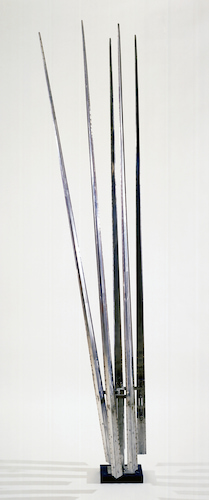Artist Birthday: George Rickey
George Rickey evolved from a painter with a love of history, to a kinetic artist who transformed stainless steel into lyrical, mesmerizing, precisely calibrated moving sculptures. Kinetic sculpture began developing during the 1950s and flourished starting in the early 1960s.
Artist birthday for 6 June: George Rickey (1907–2002, United States)
George Rickey was a pioneer of elegant, kinetic sculpture.
 |
| George Rickey, Peristyle Five Lines, 1963–1964. Stainless steel, 254 x 25.4 x 33 cm. Buffalo AKG Art Museum, Buffalo, New York. © 2025 Estate of George Rickey / Licensed by VAGA at Artists Rights Society (ARS), New York. (AK-931rkvg) |
Starting in the late 1960s, Rickey produced a series of works of varying scale called where metal forms called Lines were the subject of the composition. The work is grounded in the principle of the pendulum, which he first introduced into his sculpture in 1954. This work is part of a series of Peristyle works, in which the number of steel blades varies. Like most artists involved in motion works, Rickey hoped that movement would be as expressive as color or form. In his Peristyle works, he engineered the blades to "talk" to each other, but never collide. He derived the title Peristyle presumably from the front porch of Greek and Roman temples that featured a row of columns. Even at 2.5 meters (8 feet), this piece could conceivably be a study for a monumental outdoor work.
One direction periodically a part of sculpture since the early 1900s is motion, explored literally rather than as painted or sculpted illusion. Motion in sculpture was explored by Marcel Duchamp (1887–1968) and Naum Gabo (1890–1977), Duchamp in found objects and Gabo with his Constructivist inspired machine sculptures. László Moholy-Nagy (1895–1946) experimented with combinations of light and motion with his Light-Space Modulator sculptures.
Before World War II (1939–1945), Alexander Calder (1898–1976) was the one artist who pioneered a major form of motion in his mobile motorized reliefs and moving objects that foresaw the mobile form realized first in 1939 in Lobster Trap and Fish Tail. An important theoretician about movement was Bruno Munari (1907–1998), and Italian sculptor who produced kinetic works as early as 1933. The Spanish group Equipo 57 (founded 1957) was a group of artists who worked as an anonymous team exploring works involving motion and vision. Several other groups emerged in Milan, Padua and Düsseldorf, but the theoretical passion of the 1950s dimmed as several artists emerged individually in the 1960s.
Rickey was born in South Bend, Indiana. At six years old his family moved to Scotland. He studied history in Oxford from 1926, and then art from 1928 to 1929. In 1930 he went to Paris to further his studies in art where he became inspired by the kinetic works of Calder. Initially in the 1930s, while he supported himself first teaching at Groton College in Massachusetts, then working for Newsweek Magazine, he painted in a pseudo-Cézanne style, and then in a Social Realist style because of the Depression-era preference for realism.
During World War II, Rickey served in the Army Air Corps, testing targeting instruments used by bomber gunners. Here he learned mechanical skill and an understanding of the effects of wind and gravity on weapons, laying the path for a transition from painting to sculpture. The inspiration of Calder resurfaced, and he made his first mobile during the war in 1945. Studying at the Illinois Institute of Technology in Chicago 1948 to 1949, Rickey was further inspired to create kinetic sculptures by his teacher there, former Bauhaus instructor Moholy-Nagy, who had experimented with mechanical sculpture already in the 1920s. Rickey’s earliest works were meant to hang on the wall, made of glass, but Rickey soon substituted angular forms made from metal.

Comments